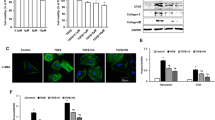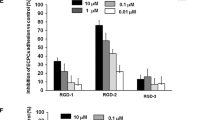Summary
The endothelial-to-mesenchymal transition (EndMT) in endothelial cells contributes to the development of cardiac fibrosis, ultimately leading to cardiac remodeling. In this study, the effects and molecular mechanisms of celastrol (CEL) on transforming growth factor-β1 (TGF-β1)-induced EndMT in human umbilical vein endothelial (HUVEC-12) cells were investigated. The presented data demonstrated that CEL significantly blocked the morphology change of HUVEC-12 cells induced by TGF-β1 without cell cytotoxicity. In accordance with these findings, CEL blocked TGF-β1-induced EndMT as evidenced by the inhibition of the mesenchymal markers, including collagen I, III, α-SMA, fibronectin mRNA expression, and the increase in the mRNA expression of endothelial cell marker CD31. These changes were also confirmed by double immunofluorescence staining of CD31 and vimentin. The in vitro scratch assay showed that CEL inhibited the migration capacity of the transitioned endothelial cells induced by TGF-β1. Further experiments showed that the beneficial effect of CEL on blocking the EndMT in HUVEC-12 cells was associated with the suppression of the TGF-β1/Smads signalling pathway, which was also confirmed by the inhibition of its downstream transcription factor snail1, twist1, twist2, ZEB1 and ZEB2. These results indicate that CEL blocks TGF-β1-induced EndMT through TGF-β1/Smads signalling pathway and suggest that it may be a feasible therapy for cardiac fibrosis diseases.
Similar content being viewed by others

References
Bujak M, Ren G, Kweon HJ, et al. Essential role of Smad3 in infarct healing and in the pathogenesis of cardiac remodeling. Circulation, 2007,116(19):2127–2138
van Amerongen MJ, Bou-Gharios G, Popa E, et al. Bone marrow-derived myofibroblasts contribute functionally to scar formation after myocardial infarction. J Pathol, 2008,214(3):377–386
Kolditz DP, Wijffels MC, Blom NA, et al. Epicardium-derived cells in development of annulus fibrosis and persistence of accessory pathways. Circulation, 2008,117(12):1508–1517
Diaz-Flores L, Gutierrez R, Madrid JF, et al. Pericytes. Morphofunction, interactions and pathology in a quiescent and activated mesenchymal cell niche. Histol Histopathol, 2009,24(7):909–969
Zeisberg EM, Tarnavski O, Zeisberg M, et al. Endothelial-to-mesenchymal transition contributes to cardiac fibrosis. Nat Med, 2007,13(8):952–961
Zeisberg M, Kalluri R. Fibroblasts emerge via epithelial-mesenchymal transition in chronic kidney fibrosis. Front Biosci, 2008, 13: 6991–6998
Li J, Qu X, Yao J, et al. Blockade of endothelial-mesenchymal transition by a Smad3 inhibitor delays the early development of streptozotocin-induced diabetic nephropathy. Diabetes, 2010,59(10):2612–2624
Hashimoto N, Phan SH, Imaizumi K, et al. Endothelial-mesenchymal transition in bleomycin-induced pulmonary fibrosis. Am J Respir Cell Mol Biol, 2010,43(2):161–172
Widyantoro B Emoto N, Nakayama K, et al. Endothelial cell-derived endothelin-1 promotes cardiac fibrosis in diabetic hearts through stimulation of endothelial-to-mesenchymal transition. Circulation, 2010,121(22):2407–2418
Murdoch CE, Chaubey S, Zeng L, et al. Endothelial NADPH oxidase-2 promotes interstitial cardiac fibrosis and diastolic dysfunction through proinflammatory effects and endothelial-mesenchymal transition. J Am Coll Cardiol, 2014,63(24):2734–2741
Kovacic JC, Mercader N, Torres M, et al. Epithelial-to-mesenchymal and endothelial-to-mesenchymal transition: from cardiovascular development to disease. Circulation, 2012,125(14):1795–1808
Piera-Velazquez S, Mendoza FA, Jimenez SA. Endothelial to Mesenchymal transition (EndoMT) in the pathogenesis of human fibrotic diseases. J Clin Med, 2016,5(4):E45
Calixto JB, Campos MM, Otuki MF, et al. Anti-inflammatory compounds of plant origin. Part II. modulation of pro-inflammatory cytokines, chemokines and adhesion molecules. Planta Med, 2004,70(2):93–103
Li PP, He W, Yuan PF, et al. Celastrol induces mitochondria-mediated apoptosis in hepatocellular carcinoma Bel-7402 cells. Am J Chin Med, 2015,43(1):137–148
Kannaiyan R, Shanmugam MK, Sethi G. Molecular targets of celastrol derived from Thunder of God Vine: potential role in the treatment of inflammatory disorders and cancer. Cancer Lett, 2011,303(1):9–20
Salminen A, Lehtonen M, Paimela T, et al. Celastrol: Molecular targets of Thunder God Vine. Biochem Biophys Res Commun, 2010,394(3):439–442
Yu X, Tao W, Jiang F, et al. Celastrol attenuates hypertension-induced inflammation and oxidative stress in vascular smooth muscle cells via induction of heme oxygenase-1. Am J Hypertens, 2010,23(8):895–903
Wang YL, Lam KK, Cheng PY, et al. Celastrol prevents circulatory failure via induction of heme oxygenase-1 and heat shock protein 70 in endotoxemic rats. J Ethnopharmacol, 2015, 162: 168–175
Porter Ke Turner Na. Cardiac fibroblasts: at the heart of myocardial remodeling. Pharmacol Ther, 2009,123(2):255–278
Travers JG, Kamal FA, Robbins J, et al. Cardiac fibrosis: the fibroblast awakens. Circ Res, 2016,118(6):1021–1040
Hua JY, Zhang ZC, Jiang XH, et al. Relationship between endothelial-to-mesenchymal transition and cardiac fibrosis in acute viral myocarditis. Zhejiang Da Xue Xue Bao Yi Xue Ban (Chinese), 2012,41(3):298–304
Zhou H, Guo H, Zong J, et al. ATF3 regulates multiple targets and may play a dual role in cardiac hypertrophy and injury. Int J Cardiol, 2014,174(3):838–839
Grotendorst GR, Rahmanie H, Duncan MR. Combinatorial signaling pathways determine fibroblast proliferation and myofibroblast differentiation. FASEB J, 2004,18(3):469–479
Chan EC, Peshavariya HM, Liu GS, et al. Nox4 modulates collagen production stimulated by transforming growth factor beta1 in vivo and in vitro. Biochem Biophys Res Commun, 2013,430(3):918–925
Chen LX, Yang K, Sun M, et al. Fluorofenidone inhibits transforming growth factor-beta1-induced cardiac myofibroblast differentiation. Pharmazie, 2012,67(5):452–456
Deng YL, Xiong XZ, Cheng NS. Organ fibrosis inhibited by blocking transforming growth factor-beta signaling via peroxisome proliferator-activated receptor gamma agonists. Hepatobiliary Pancreat Dis Int, 2012,11(5):467–478
Zhan CY, Tang JH, Zhou DX, et al. Effects of tanshinone IIA on the transforming growth factor beta1/Smad signaling pathway in rat cardiac fibroblasts. Indian J Pharmacol, 2014,46(6):633–638
Author information
Authors and Affiliations
Corresponding author
Rights and permissions
About this article
Cite this article
Gong, F., Zhao, F. & Gan, Xd. Celastrol protects TGF-β1-induced endothelial-mesenchymal transition. J. Huazhong Univ. Sci. Technol. [Med. Sci.] 37, 185–190 (2017). https://doi.org/10.1007/s11596-017-1713-0
Received:
Revised:
Published:
Issue Date:
DOI: https://doi.org/10.1007/s11596-017-1713-0



